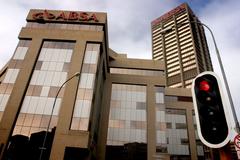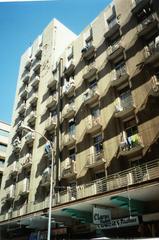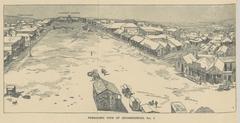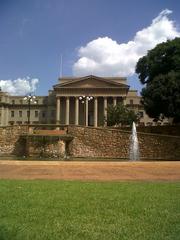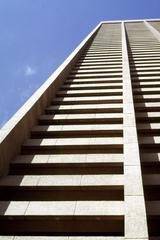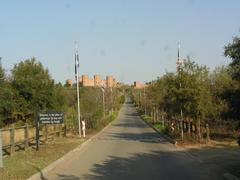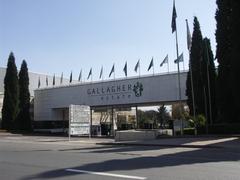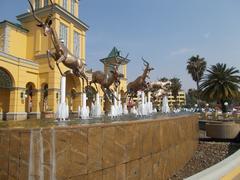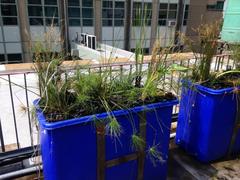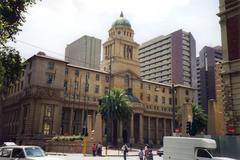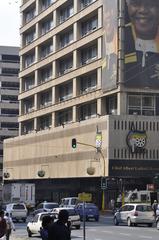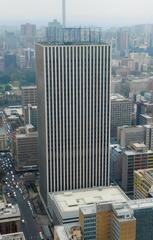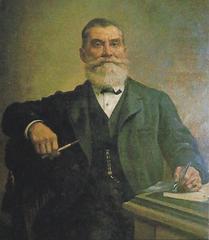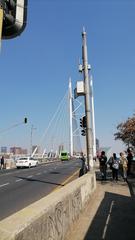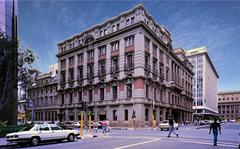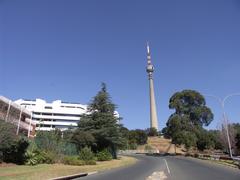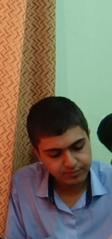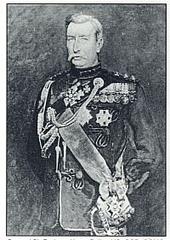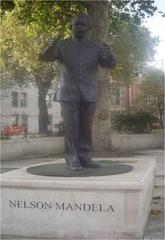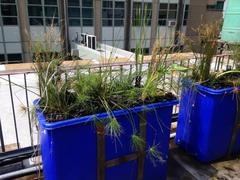Trust Bank Building Johannesburg: Visiting Hours, Tickets, and Travel Guide
Date: 14/06/2025
Introduction: A Landmark of Johannesburg’s Urban and Economic History
Rising above the heart of Johannesburg’s Central Business District (CBD), the Trust Bank Building is a defining feature of the city’s skyline and a monument to its financial and architectural ambition. Completed in 1970 and designed by the firm Colyn & Meiring, this 140-meter skyscraper exemplifies the international modernist trends of the late 20th century—characterized by sleek glass curtain walls, reinforced concrete, and a bold vertical emphasis (Johannesburg Heritage Foundation; Artefacts). Once the headquarters of one of South Africa’s major banks, the building is both a symbol of economic growth during the apartheid era and an enduring part of Johannesburg’s urban identity.
This comprehensive guide explores the Trust Bank Building’s architectural features, historical context, visitor information, accessibility, and travel tips—essential reading for anyone interested in Johannesburg’s rich heritage.
Table of Contents
- The Rise of Banking in Early Johannesburg
- Origins, Construction, and Architectural Features
- Economic and Cultural Significance
- Visiting the Trust Bank Building: Hours, Tickets, Accessibility
- Guided Tours and Visitor Experiences
- Nearby Attractions and Travel Tips
- Preservation and Contemporary Relevance
- Frequently Asked Questions (FAQ)
- Conclusion and Visitor Recommendations
- Sources and Further Reading
The Rise of Banking in Early Johannesburg
Johannesburg’s transformation from a mining camp to a bustling metropolis began with the discovery of gold on the Witwatersrand in 1886 (aswica.co.za). Rapid urban growth demanded new financial infrastructure, leading to the establishment of major banks and the Johannesburg Stock Exchange. As the city’s economy flourished, imposing bank buildings became central to the character of the CBD, reflecting the city’s economic vitality.
Origins, Construction, and Architectural Features
Commissioned at the height of Johannesburg’s mid-20th-century development boom, the Trust Bank Building was completed in 1970 as the headquarters for Trust Bank, a prominent financial institution. Its 31-storey form, vertical proportions, and modernist style represent the era’s focus on efficiency, transparency, and corporate confidence (Wikipedia: Trust Bank Building; Skyscraper Center).
Key Architectural Features
- Glass Curtain Walls: The building’s façade reflects the cityscape and provides abundant natural light.
- Reinforced Concrete Structure: Ensures durability, fire resistance, and supported one of the country’s largest bank vaults.
- Vertical Emphasis: Height and slenderness accentuate its prominence among Johannesburg’s high-rises.
- Integrated Retail Spaces: The street-level design invites pedestrian activity, a hallmark of urban modernism (Artefacts; Heritage Register PDF).
The building’s location at 56 Eloff Street places it among other modern and historic landmarks, such as the Standard Bank Centre, Carlton Centre, and the Art Deco Ansteys Building (Wikipedia: History of Johannesburg).
Economic and Cultural Significance
The Trust Bank Building not only embodied the aspirations of South Africa’s financial sector during the apartheid era but also became a central reference point for the city’s economic and architectural development. As a headquarters, it facilitated crucial financial operations and reinforced Johannesburg’s status as the “City of Gold” (Mail & Guardian).
In recent years, the building has become an important marker in heritage walking tours and urban revitalization efforts, symbolizing both the challenges and opportunities of Johannesburg’s evolving cityscape (Rough Guides).
Visiting the Trust Bank Building: Hours, Tickets, and Accessibility
Visiting Hours
- Exterior Viewing: The building’s exterior can be viewed at any time, but the best hours are Monday to Friday, 8:00 AM – 5:00 PM.
- Interior Access: Public entry to the interior is restricted. Access is generally limited to ground-floor retail spaces, which are open during standard business hours.
- Guided Tours: Available through heritage organizations and local tour operators, typically scheduled during business hours. Advance booking is recommended for guaranteed access.
Tickets and Admission
- Exterior Viewing: Free of charge.
- Guided Tours: Ticket prices vary depending on the provider and itinerary. Some tours are free; others require advance payment.
Accessibility
- Transport: The building is centrally located, accessible via Gautrain (Park Station), Rea Vaya BRT, and registered taxis or ride-sharing services.
- Wheelchair Access: The main entrance and nearby sidewalks are generally accessible, but elevator access inside the building may be limited for public tours.
- Safety: Visit during daylight hours, preferably as part of a group or guided tour.
Guided Tours and Visitor Experiences
While the Trust Bank Building is not open as a public museum, it features prominently in architectural and heritage walking tours of Johannesburg’s CBD. Tours provide:
- Fascinating historical and architectural commentary.
- Insights into the building’s role in Johannesburg’s economic development.
- Opportunities for exterior photography, especially during early morning or late afternoon when the glass façade catches the light (Johannesburg Heritage Foundation).
For current tour offerings, consult local heritage organizations or download the Audiala app for guided experiences and real-time visitor information.
Nearby Attractions and Travel Tips
Within Walking Distance:
- Carlton Centre: Africa’s tallest building, with an observation deck.
- Gandhi Square: A lively commercial and public transit hub.
- Johannesburg City Library: Edwardian architectural gem.
- MuseuMAfricA and Chancellor House: Explore Johannesburg’s social and political history.
- Market Theatre: Renowned for its role in the city’s cultural life.
Travel Tips:
- Wear comfortable, casual clothing and sturdy shoes.
- Sun protection is recommended.
- Avoid displaying valuables and use reputable transport.
- Visit during business hours for the safest and most vibrant experience.
Preservation and Contemporary Relevance
Despite facing periods of neglect and commercial migration out of the CBD, the Trust Bank Building remains structurally sound and visually striking. Recent urban renewal initiatives have seen parts of the building adapted for retail, with ongoing discussions about further refurbishment and adaptive reuse (Heritage Register PDF). The building continues to serve as a touchstone for heritage conservation and urban revitalization in Johannesburg.
Frequently Asked Questions (FAQ)
Q: Can I go inside the Trust Bank Building? A: Public access is limited to ground-floor retail areas. Guided tours may occasionally offer access to other parts of the building, subject to prior arrangement.
Q: Are tickets required? A: No tickets are needed for exterior viewing. Guided tours may require advance booking and payment.
Q: Is the building wheelchair accessible? A: The entrance and surrounding sidewalks are accessible, but interior elevator access is not guaranteed for public tours.
Q: When is the best time to visit or photograph the building? A: Weekdays during business hours; early morning and late afternoon offer the best natural light.
Q: What safety precautions should I take? A: Visit in groups or with a guide, keep valuables secure, and use reputable transport services.
Conclusion and Visitor Recommendations
The Trust Bank Building is a cornerstone of Johannesburg’s architectural and economic landscape. While public entry is restricted, its impressive exterior, central location, and inclusion in heritage tours make it an essential stop for anyone exploring the city’s history. For a richer experience, participate in a guided tour, explore nearby attractions, and use digital resources like the Audiala app for up-to-date information.
Best Time to Visit: Weekdays, 8:00 AM – 5:00 PM
Photography: Welcome from the exterior—respect privacy and building regulations
Dress Code: Comfortable and practical for urban exploration
Sources and Further Reading
- Johannesburg Heritage Foundation
- Wikipedia: History of Johannesburg
- Artefacts: Trust Bank Building
- Skyscraper Center: Trust Bank Building
- Mail & Guardian: The tales behind Johannesburg’s skyscraper architecture
- Rough Guides: A first-timer’s guide to Johannesburg
- Wikipedia: Trust Bank Building
- Heritage Register PDF: Trust Bank Building Survey
For more travel tips, heritage insights, and guided experiences, follow Johannesburg Heritage Foundation and download the Audiala app.

